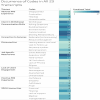Navigating barriers and embracing facilitators of connection: insights from peer recovery specialists working with individuals with substance use disorder and criminal justice involvement: a qualitative analysis
- PMID: 39873840
- PMCID: PMC11776266
- DOI: 10.1186/s40352-024-00300-w
Navigating barriers and embracing facilitators of connection: insights from peer recovery specialists working with individuals with substance use disorder and criminal justice involvement: a qualitative analysis
Abstract
Background: Substance use disorder affects over half of incarcerated individuals, with 23% experiencing opioid use disorder specifically. Addressing opioid use disorder in jails is crucial due to its association with increased recidivism and overdose. This study investigates the experiences of peer recovery specialists working with individuals with opioid use disorder and criminal justice involvement, focusing on barriers and facilitators to client connections. Qualitative interviews were conducted and thematically analyzed using a hybrid inductive and deductive coding approach. The sample involved five peer recovery specialists, who were interviewed multiple times, across three sites in Virginia between August 2022 to December 2023.
Results: This analysis categorized findings into two main domains: barriers to connection and facilitators of connection. Within the barriers to connection, six themes emerged: jail specific restrictions, client in withdrawal, social determinants of health insecurities, lack of client engagement, disconnection, and adverse peer recovery experience. Jail-specific restrictions was the most common barrier to connection with 91.30% of transcripts referencing at least one code for jail-specific restrictions; 73.91% of all transcripts indicated social determinants of health insecurities; 56.52% of all peer recovery specialist transcripts experienced clients in withdrawal; 52.17% of all transcripts identified lack of client engagement; 43.48% of all transcripts identified disconnection as a barrier; and 34.78% of all transcripts indicated adverse peer recovery specialist experiences. Three themes were identified as facilitators of connection: peer communication skills, connection to services, and positive peer recovery specialist experience. Peer communication skills were by far the most prominent, with 100% of all transcripts indicating a code related to peer communication skills; 60.87% of all transcripts indicated positive peer recovery specialist experience; and 56.52% of all transcripts identified connection to services as a facilitator. Notable discrepancies in code frequency were observed across different sites, suggesting site specific challenges.
Conclusion: This study offers valuable insights into enhancing peer-based support programs within the justice system for individuals with opioid use disorder. Barriers such as jail specific restrictions, client withdrawal, and social determinants of health insecurities pose significant challenges, while effective communication emerges as a critical facilitator. Findings emphasize the need for collaborative efforts between justice and recovery partners to optimize the impact of peer-based support services.
Keywords: Criminal Justice; Incarceration; Jail; Opioid Treatment; Opioid Use Disorder; Peer Recovery; Peer Support; Recovery; Reentry; Substance Use.
© 2025. The Author(s).
Conflict of interest statement
Declarations. Ethics approval and consent to participate: This research was conducted in accordance with the Declaration of Helsinki. All study procedures were approved by the George Mason University Institutional Review Board (Reference Number: 2166202–1). Research Exemption was approved on April 29th, 2024. The data was originally intended for program evaluation purposes and therefore, individual consent was not obtained from participants. Competing interests: The authors declare no competing interests.
Figures







References
-
- Bassuk, E. L., Hanson, J., Greene, R. N., Richard, M., & Laudet, A. (2016). Peer-delivered recovery support services for addictions in the United States: A systematic review. Journal of Substance Abuse Treatment,63, 1–9. 10.1016/j.jsat.2016.01.003 - PubMed
-
- Booty, M., Harp, K., Batty, E., Knudsen, H., Staton, M., & Oser, C. (2023). Barriers and Facilitators to the Use of Medication for Opioid Use Disorder within the Criminal Justice System: Perspectives from Clinicians. Journal of Substance Use and Addiction Treatment,149, 209051. 10.1016/j.josat.2023.209051 - PMC - PubMed
-
- Braun, V., & Clarke, V. (2006). Using thematic analysis in psychology. Qualitative Research in Psychology,3(2), 77–101. 10.1191/1478088706qp063oa
-
- Eddie, D., Hoffman, L., Vilsaint, C., Abry, A., Bergman, B., Hoeppner, B., Weinstein, C., & Kelly, J. F. (2019). Lived Experience in New Models of Care for Substance Use Disorder: A Systematic Review of Peer Recovery Support Services and Recovery Coaching. Frontiers in Psychology,13(10), 1052. 10.3389/fpsyg.2019.01052PMID:31263434;PMCID:PMC6585590.DOI:10.3389/fpsyg.2019.01052 - PMC - PubMed
Grants and funding
- 107962/Virginia Department of Health Office of Health Equity
- 107962/Virginia Department of Health Office of Health Equity
- 107962/Virginia Department of Health Office of Health Equity
- 107962/Virginia Department of Health Office of Health Equity
- 107962/Virginia Department of Health Office of Health Equity
LinkOut - more resources
Full Text Sources

